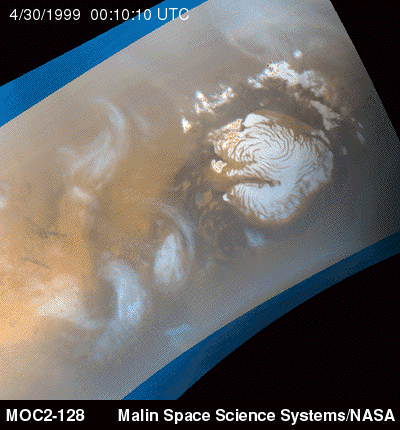
Mars Global Surveyor
Mars Orbiter Camera
Clouds in North Polar Region Tracked by MOC Over Five Day
Period
MGS MOC Release No. MOC2-128, 21 May
1999

It is mid-summer in the northern hemisphere of Mars--a time of enhanced
heating that leads to the release of water vapor into the atmosphere. In
the north polar region, temperature differences between bright areas of
year-round ice and dark areas of sand and rock create strong winds that
mix the atmosphere and create waves of clouds that swirl around the polar
cap. Sometimes, as seen during the Viking mission, these winds form tight
cyclones; other times, they weave an intricate pattern reflecting the turbulance
of the circulation of the atmosphere.
This animation shows four days of observations of a representative portion
of the northern hemisphere. Five Mars Orbiter Camera (MOC) wide angle image
pairs (red/blue filters) were combined. These image pairs were warped to
create a polar stereographic map projection, which is used by cartographers
to present polar areas as if viewed from above. The edges of the pictures
move back and forth because of the slightly different path taken by the
Mars Global Surveyor spacecraft on each of the five orbits used in this
sequence. Seen in the right-hand side of the image is the permanent ice
cap and the dark areas that surround it.
The motion of the clouds viewed in this image is typical for this season
on Mars, and shows forms often seen on Earth. Waves of clouds are moving
from the upper portion of the frame towards the bottom (towards the east northeast).
This motion is most likely the movement of a moister portion of the martian
atmosphere under the influence of circumpolar winds. Early in the sequence,
a prominent circular band of clouds moves almost due east, rotating slightly
counter-clockwise. Towards the end of the sequence, the circle dissipates
and a linear set of clouds propagates towards the bottom of the frame. Linear
cloud speeds vary from day to day, averaging about 16 km/hr (10 miles/hr);
rotational rates appear to have been less than 10 km/hr (6 miles/hr).
Malin Space Science Systems and the California Institute of Technology
built the MOC using spare hardware from the Mars Observer mission. MSSS
operates the camera from its facilities in San Diego, CA. The Jet Propulsion
Laboratory's Mars Surveyor Operations Project operates the Mars Global Surveyor
spacecraft with its industrial partner, Lockheed Martin Astronautics, from
facilities in Pasadena, CA and Denver, CO.
 To
MSSS Home Page
To
MSSS Home Page
Contact: info@msss.com

